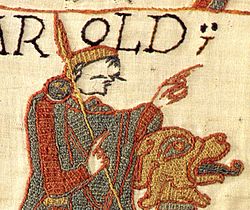Backstitch


Backstitch or back stitch and its variants stem stitch, outline stitch and split stitch are a class of
Description of the technique
A versatile stitch which is easy to work, backstitch is ideal for following both simple and intricate outlines and as a foundation row for more complex embroidery stitches such as herringbone ladder filling stitch. Although superficially similar to the
Basic backstitch is the stitch used to outline shapes in modern
Stem stitch is an ancient technique; surviving mantles embroidered with stem stitch by the
Split stitch in silk is characteristic of

Backstitch is most easily worked on an
Neatly worked in a straight line this stitch resembles chain stitching produced by a sewing machine.
The back stitch can also be used as a hand sewing utility stitch to attach two pieces of fabric together.[1]
Variants
Variants of backstitch include:
- Basic backstitch or point de sable.
- Threaded backstitch
- Pekinese stitch, a looped interlaced backstitch
- Stem stitch, in which each stitch overlaps the previous stitch to one side, forming a twisted line of stitching, with the thread passing below the needle. It is generally used for outlining shapes and for stitching flower stems[6] and tendrils.
- Whipped back stitch using thread of a different color than the original stitch, the needle is passed under the stitch without piercing the fabric, repeated to create a colorful twisted effect
- Outline stitch, sometimes distinguished from stem stitch in that the thread passes above rather than below the needle.
- Split stitch, in which the needle pierces the thread rather than returning to one side.
- Ringed back stitch, back stitches are worked to create half rings, these are completed by a second row of stitches to form ring outlines
Stitch gallery
-
Pekinese stitch
-
Stem stitch
-
Whipped stem stitch
-
Split stitch
See also
- Assisi embroidery
- Blackwork embroidery
- Cross-stitch
- Embroidery stitches
Notes
- ^ a b "Back Stitch". Sarah's Hand Embroidery Tutorials. Retrieved 2020-06-22.
- ^ How to do the Back Stitch, archived from the original on 2021-12-13, retrieved 2020-06-22
- ISBN 0-442-22318-8, p. 65
- ^ ISBN 1-85177-126-3
- ^ "Understanding the Backstitch". Teach You To Sew. Retrieved 2019-02-17.
- ISBN 0-89577-059-8, p. 48
References
- Caulfield, S.F.A., and B.C. Saward, The Dictionary of Needlework, 1885.
- Eaton, Jan. Mary Thomas's Dictionary of Embroidery Stitches, Revised by Jan Eaton. London: Hodder&Stoughton, 1989. ISBN 0-340-51075-7
- Enthoven, Jacqueline: The Creative Stitches of Embroidery, Van Norstrand Rheinhold, 1964, ISBN 0-442-22318-8
- Reader's Digest, Complete Guide to Needlework. The Reader's Digest Association, Inc. (March 1992). ISBN 0-89577-059-8
- Levey, S. M. and D. King, The Victoria and Albert Museum's Textile Collection Vol. 3: Embroidery in Britain from 1200 to 1750, Victoria and Albert Museum, 1993, ISBN 1-85177-126-3
- Sarah's Hand Embroidery Tutorials.







